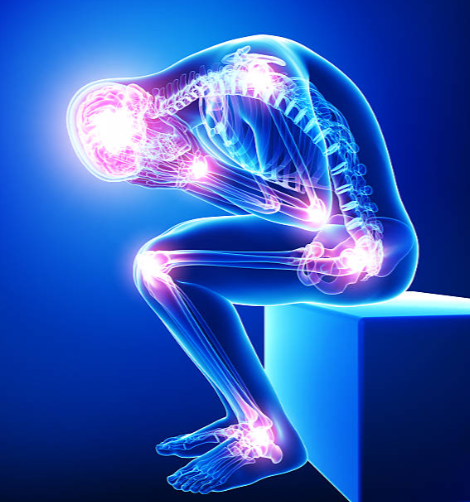
Inflammation can turn from a heroic healer to a trespassing terror. High praise can be given to the body’s inflammatory response but when it goes into overdrive it can cause havoc within your body, causing you to feel tired and have aches and pains which can be subtle or severe.

What is Inflammation
Inflammation is an essential process for our body to heal, but it is often thought of as “bad” because people associate it with wounds, red, raw swellings, and intolerable aches and pains. It is part of the body's defense mechanism and the "second line of defense" against harmful invaders. (1,2) Without inflammation our injuries and infections would never heal. However, when inflammation goes on for longer than it needs to, the healing powers wear off and is replaced by the chronic inflammation which is harmful for your body.
Let’s delve into the basics to understand acute vs chronic inflammation:
- What is inflammation and where does it come from?
- Different types of inflammation?
- Symptoms commonly associated with chronic inflammation
- What is IL-6 and how does this affect inflammation?
- Risk factors for Chronic Inflammation
- What can you do to calm Inflammation?
What is inflammation and where does it come from?
Inflammation is a way for the body to protect itself; it’s how your immune system reacts to an injury, virus, bacteria, or chemical toxins etc. to trigger your body’s healing process. The first responders are a group of proteins called cytokines. These cytokines are chemical messengers that tell your immune system where to go, what to do, and what needs to be produced to help your body heal.
Say you cut your foot, cytokines will instruct infection-fighting plasma proteins to gather in the nearby tissue, fighting together with an army of white blood cells and prostaglandins that can create a blood clot to stop the bleeding. They will order smaller blood vessels to widen to allow more inflammatory cells to join the war. The increase in cells can cause an increase in fluid causing swelling. The pain and discomfort are caused by this fluid build-up putting pressure on the nerve endings in the area. The heat and redness are caused by the increased blood flow to the area.
“The symptoms of an infection are not caused by the pathogen, but by the body’s inflammatory response.”
Different types of inflammation?

Figure: Types of Inflammation, Oxidative Medicine and Cellular Longevity (4)
Although we need inflammation in acute situations, when acute inflammation goes on for longer than it should it becomes Chronic. It’s Chronic inflammation that causes. There are two main types of inflammation - acute and chronic.
Acute inflammation aids in recovery or injury. It is a response to short-term, acute injuries, infections, and illnesses with localized effects. Pain, swelling, redness, heat, and even loss of function are characteristics of acute inflammation. For example, if a mosquito bites you, it may result in redness, swelling, and itching. During allergy season, you may experience sneezing or redness in your eyes. If you catch a cold, you may have a red, sore throat with swelling and a runny nose.
Acute Inflammation: our bodies healer
Our immune system’s natural defense against harmful microbes, irritants, chemicals, and toxins. It keeps us alive and is essential for healing when we are injured. It is short-acting and purposeful.
Chronic inflammation occurs when your immune system doesn’t or can’t switch off acute inflammation and it goes into overdrive. Chronic Inflammation can be harder to manage and diagnose, especially if you have low grade chronic inflammation. With chronic low-grade inflammation you may not even realized your body is in overdrive, you more than likely have normalized persistent symptoms from acute inflammation (5). You may just feel like you are more tired than normal, your stomach is a little sore but nothing you can’t manage, and your wrist joint is a little achy. With all these symptoms you’ve told yourself it’s just aging, or downplayed how you’re feeling as you don’t have time to be sick, so you just push on through.
Then things finally get worse, so you go to the doctor and now you’ve been diagnosed with a condition.
Symptoms commonly associated with chronic inflammation.

Figure: (5)
Persistent Fatigue: Chronic inflammation can lead to increased production of certain chemicals that contribute to fatigue and malaise. If you find yourself consistently tired despite adequate rest, it may be worth considering inflammation as a potential factor.
Joint Pain and Stiffness: Inflammation can target the joints, causing pain, stiffness, and reduced flexibility. If you're experiencing persistent joint discomfort without an apparent cause, it's essential to investigate the possibility of inflammation.
Frequent Infections: Individuals with chronic inflammation may experience an increased susceptibility to infections due to a compromised immune system.
Digestive Issues: Chronic inflammation in the digestive tract can lead to problems such as bloating, gas, constipation, or diarrhea. If you notice recurring digestive issues, inflammation may be contributing towards your issues.
Skin Problems: Conditions like eczema, psoriasis, or acne may be exacerbated by chronic inflammation. Skin issues that seem resistant to conventional treatments might be linked to an underlying inflammatory response.
Unexplained Weight Changes: Inflammation can impact the body's metabolism and lead to unexplained weight gain or loss. If you're facing changes in weight without a clear cause, inflammation might be a contributing factor.
Cognitive Dysfunction/headaches: Inflammation in the brain may be associated with cognitive issues, including difficulties with memory and concentration.
Chronic inflammation: a silent killer.
A lot of common, serious conditions are caused by inflammation. Chronic inflammation is when our immune system is over-activated for a long time leading to chronic disease.
If you suspect chronic inflammation may be affecting you, take advantage of our FREE 15-minute consultation to see if we can help you today
Risk factors for Chronic Inflammation

Figure: Risk Factors for Chronic Inflammation (5)
Obesity: Adipose tissue (fat) that settles around the chest and belly are associated with higher levels of inflammation that is implicated in inflammation of the heart, insulin resistance, diabetes, atherosclerosis and non-alcoholic fatty liver disease, estrogen dominance, mood imbalances, increased risk of cancer and dementia. The interesting thing about adipose tissue is that besides the chronic inflammation it creates in the body it also becomes inflamed itself and releases more IL-6. This becomes a dangerous symbiosis. Fat cells when grown together with cancer cells, encourage cancer cells to produce more cytokines as well and so a vicious cycle is born. (5, 8, 9, 12).
Diet: A diet low in nutrients is one of the major causes of chronic inflammation. It includes a lot of processed food, refined sugars, starches, unhealthy fats, monosodium glutamate (MSG), gluten, casein, aspartame, and alcohol. It lacks greens, veggies, and fruit making it low in vitamins, minerals, and antioxidants. Foods that you might be sensitive or allergic to may also cause chronic inflammation. Fibre, which is essential for healthy detoxification and digestion, is also lacking in most diets today. To help reduce inflammation one should move away from this type of inflammatory diet to an anti-inflammatory diet that is rich in organic whole foods that include greens, veggies, fruit, anti-inflammatory herbs, good fats, and high-quality animal products (3).
Stress: Chronic stress plays a major role in the development of chronic inflammation. Stress alters the actions of immune cells because the macrophages become angry and maladaptive, increasing the number of cytokines released in the body. Poor eating habits, alcohol consumption, lack of exercise, and poor sleeping habits are all due to emotional and life stress. Chronic stress causes your body to be in a constant fight or flight state which may result in digestive disorders and anxiety.

Sleep problems: Having a good night’s sleep is crucial when it comes to your health and well-being. When we sleep our bodies take the time to rest, repair, and heal themselves. Poor sleeping habits and too little sleep can cause chronic low-grade inflammation as it can provoke increased IL-6 secretions. Sleep apnea is another cause of concern when it comes to getting enough sleep. Intermittent episodes of low oxygen levels in the blood can exacerbate hidden inflammation. Studies have reported that people with insomnia have higher IL-6 levels at nighttime (3, 5, 11,12).
Smoking: The phrase “smoking can kill you” is true. Nicotine causes inflammation throughout the body. It is not just tobacco smoke but also alternative forms of nicotine inhalation such as vaping. Smoking alters your immune system response, increasing the levels of pro-inflammatory responses and causing inflammation in the lungs that can lead to COPD and various lung disorders (5,13)
Age: Ageing is the one thing we can’t escape. We all experience the slowing down of the body. Stuff just doesn’t work as it used to, and you can’t do the same things with the same ease you did when you were younger. With age comes various ailments, symptoms, and diseases, all because of a low-grade inflammation you develop with age. This low-grade inflammation is the consequence of the immune system increasing cytokine production in the body. Genetic, environmental, and age-related factors all play a role in your vulnerability or resilience to inflammaging and related symptoms.
Fortunately, we don’t have to accept this as inevitable. You can still experience a vibrant, full, and healthy life at any age. (14,15)

Take back control and reduce your inflammation levels today!

What can you do to calm Inflammation?
So, what can you take away from this exploration of inflammation? Firstly, it underscores the importance of maintaining a healthy lifestyle to minimize chronic inflammation – six key things you can start doing today:

Figure 3: How to fight inflammation, from The Essential Series. The Anti-inflammatory Handbook. (5)
Not sure where to start? Think about three things you can do to start helping yourself today, consider:
- Coming in to see us to get your If you are concerned about your inflammation levels IL-6 tested today.
- Look at your diet and increase anti-inflammatory foods, it may be something as simple as having a goal to eat ½ cup of vegetables every day and then build on this.
- Drink more water
- Work on exercising, consistently
- Breathing
Secondly, it highlights the potential of personalized medicine.
Not sure if these products are suitable for you? Book in a FREE discovery call here
Reference:
- William L. Stone; Hajira Basit; Bracken Burns. (2014). Pathology, Inflammation. https://www.ncbi.nlm.nih.gov/books/NBK534820/
- Roma Pahwa; Amandeep Goyal; Ishwarlal Jiala. (2023). Chronic inflammation. https://www.ncbi.nlm.nih.gov/books/NBK493173/#:~:text=Inflammation%20is%20part%20of%20the,Acute%20Inflammation
- Dr. Jockers. (2024). Top 4 Herbs to Reduce Inflammation Instead of NSAIDs. https://drjockers.com/herbs-reduce-inflammation/
- Arulselvan, Palanisamy & Tangestani Fard, Masoumeh & Tan, Woan & Sivapragasam, Gothai & Fakurazi, Sharida & Me, Norhaizan & SureshKumar, S. & Kumar, Suresh. (2016). Role of Antioxidants and Natural Products in Inflammation. Oxidative Medicine and Cellular Longevity. 2016. 10.1155/2016/5276130.
- The Essential Series. The Anti-inflammatory Handbook. (2023). Future Publishing LTD.
- Hansbro, P. (2023). The good gut anti-inflammatory diet. Pantera Press.
- Thomas, L. (2021). What is interleukin 6? https://www.news-medical.net/health/What-is-Interleukin-6.aspx
- Ferrante, A. W. (2007). Obesity induced inflammation: a metabolic dialogue in the language of inflammation. https://doi.org/10.1111/j.1365-2796.2007.01852.x
- Dr. Jockers. (2024). Visceral fat: what is it and how it drives up inflammation. https://drjockers.com/visceral-fat/
- Dolsen, E. A., Crosswell, A. D., & Prather, A. A. (2019). Links Between Stress, Sleep, and Inflammation: Are there Sex Differences? Current psychiatry reports, 21(2), 8. https://doi.org/10.1007/s11920-019-0993-4
- Simpson, N. & Dinges, D. F. (2007). Sleep and inflammation. https://onlinelibrary.wiley.com/doi/pdf/10.1111/j.1753-4887.2007.tb00371.x
- Ravella, S. (2022). A Silent Fire: the story of inflammation, diet, and disease. The Bodley Head, London
- Wang, H., Chen, H., Fu, Y., Liu, M., Zhang, J., Han, S., Tian, Y., Hou, H., & Hu, Q. (2022). Effects of Smoking on Inflammatory-Related Cytokine Levels in Human Serum. Molecules (Basel, Switzerland), 27(12), 3715. https://doi.org/10.3390/molecules27123715
- Baylis, D., Bartlett, D. B., Patel, H. P., & Roberts, H. C. (2013). Understanding how we age: insights into inflammaging. Longevity & healthspan, 2(1), 8. https://doi.org/10.1186/2046-2395-2-8
- Dr Jockers. (2024). Inflammaging: The role of inflammation in the acceleration of aging. https://drjockers.com/inflammaging/


